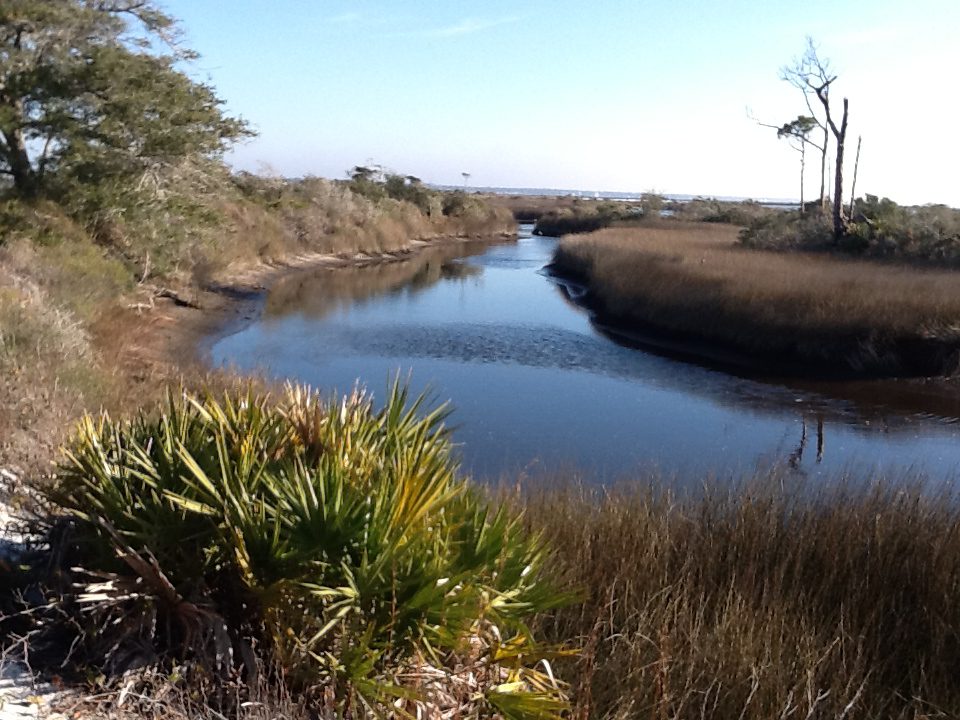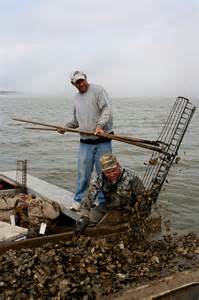You cannot have a healthy estuary without healthy habitats. Estuaries include habitats such as mud flats, sand bottoms, salt marshes, mangrove swamps, oyster reefs, and seagrass meadows. Here in the Pensacola Bay system Florida Sea Grant has been focusing on the health and restoration of salt marshes, oyster reefs, and seagrass meadows. We have also been watching the northern dispersal of mangroves into this part of the Gulf of Mexico.

Photo: Rick O’Connor
Salt marshes are grass habitats that exist in protective coves and inlets within the estuary. They are made of emergent grasses that live in the intertidal zones of these beaches. They are dominated by three species that create a specific profile from the water inland. Smooth cordgrass is the grass most common along the water’s edge. Preferring higher salinities (at or above 20 ppt) they are more common in the lower estuary. They are the most water tolerant of the grasses and found from the mean high tide line seaward, often found in water at both high and low tide. Being emergent grass, their root system is below water level anchoring and capturing sediments, but the green leafy portion is above the water line absorbing the sunlight.
A little further inland is black needlerush. Standing about 3-4 feet tall, it is a brown/black/gray colored needle that is in the water at high tide but often not at low. Needlerush is the most abundant grass in our salt marshes extending for acres in some locations. It traps sediment running from the land and forms a detritus rich mud substrate. Walking in this mud will release hydrogen sulfide (a rotten egg smell) and turning clothes dark brown and filling your shoes. The smell is due to bacteria in the sediments breaking down leaf material, animal carcasses, and animal waste releasing the hydrogen sulfide.
Inland from the needlerush is a small grassy plant called marsh hay. This plant is in the same genus as smooth cordgrass but prefers to be out of the water most of the time. It can tolerate being wet during extreme high tides and tropical storms, but not on a daily basis.
Salt marshes support several groups of wildlife species including the more upland raccoon, the intertidal fiddler crabs and periwinkles, and the more aquatic killifish, blue crab, and mullet. The basis for the food web in this habitat is the detritus (decayed plant and animal material found on, and in, the mud).

Photo: Florida Sea Grant
Oyster reefs are made predominantly of the sessile bivalve we call the oyster. As adults, oysters cement themselves to hard substrate like cement rocks and walls, pilings, boat bottoms, but most often to each other. A small group of oysters cemented together is called an oyster clump, and these can be found throughout the estuary along the bottom. In some locations oyster clumps cement together forming large reefs which can cover hundreds of square yards of bay bottom.
Oysters are filter feeders removing tons of plankton from the water column each day. Their feeding process includes an “intake snorkel” called a siphon. There is a second siphon for expelling waste. This water “vacuum system” can cycle almost 50 gallons of bay water/oyster/hour. This filtering process removes much of the sediment in the water column improving water clarity, as well as removing a lot of plankton from the water reducing the potential of algal blooms.
In addition to improving the overall water quality of the water, oyster reefs provide great habitat for a variety of estuarine vertebrates and invertebrates. Mud crabs, shrimp, sea anemones, and tubeworms are just a few of the invertebrates you can find here. Sheepshead, toadfish, and blennies are three common fish found here. It has been documented that the oyster reef may be the biologically most productive habitat in the estuary.

Photo: Rick O’Connor
Seagrasses differ from marsh grasses in that they are submergent, not emergent – meaning the entire plant is submerged at all times. They differ from seaweeds in that they are vascular plants, not non-vascular as seaweeds are. Seagrass meadows are amazing places to snorkel in. Like salt marshes, the diversity of grasses is low, but the abundance and acreage covered is high. These meadows have been reported to support 80-90% of the commercially important fin and shellfish as nurseries in their younger days. Like salt marshes, there is a zonation where the different species of seagrasses are found.
In lower portions of the estuary, where the salinity is higher, you find shoal and turtle grass. Both grasses have flat blades, but one is wider than the other. Turtle grass is wider, about the width of St. Augustine grass, and because of this it grows in deeper water away from shore where it is not as exposed to the waves. Shoal grass is very thin, almost like human hair. Because of this they are more tolerant of waves and will grow in shallower water. Widgeon grass resembles shoal grass but instead of being a single blade, it is branched. This seagrass can tolerate lower salinities and is more common in the upper portions of the estuary and in our bayous.
All three of these habitats have suffered over the past half century. Stormwater runoff due to coastal development has introduced sediments, that can literally cover oyster reefs and seagrass beds, as well as nutrients, which can trigger algal blooms and reducing water clarity and killing seagrasses. As we mentioned, oyster reefs are good at removing plankton from the water battling this water clarity issue, but these reefs have suffered from too much sediment and overharvesting by humans as a food source. Salt marshes have been removed for waterfront developments allowing more runoff to enter the bay and contributing the decline of all three habitats.
Florida Sea Grant’s response to this has been education efforts on restoration. Living shorelines can restore both salt marsh and oyster habitat along the shorelines. Many of these projects have been on public lands but private waterfront property owners can build a living shoreline as well. Along with the Florida Department of Environmental Protection, and other partners, Sea Grant has been training local marine contractors how to plant a living shoreline and offer that as part of their business.
Most restoration attempts of seagrass meadows have not been successful. Florida Sea Grant oversees a citizen science seagrass monitoring project entitled Eyes on Seagrass to determine if the seagrass is restoring themselves. Working with Dr. Jane Caffrey at the University of West Florida, volunteers collect data on the grass and water samples to monitor water quality at their sites. Anecdotal reports suggest that are seagrasses are doing pretty well in most locations.
If you are interested in learning more about living shorelines or want to become part of the Eyes on Seagrass project, contact your county extension office.
 4
4
